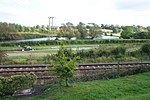Tottenham House is a large Grade I listed English country house in the parish of Great Bedwyn, Wiltshire, about five miles southeast of the town of Marlborough. It is separated from the town by Savernake Forest, which is part of the Tottenham Park estate.
The site of the house was part of the much larger Savernake Forest, and in the Middle Ages was controlled by heads of the Esturmy family. In the 15th century, the land passed by marriage to the House of Seymour of nearby Wulfhall, about one mile to the south. The original house was probably built in about 1575 by Edward Seymour, 1st Earl of Hertford, a nephew of Queen Jane Seymour, when it was known as Totnam Lodge. The present house incorporates parts of the earlier houses on the site built by the Seymours. In 1675, the estate passed to Lady Elizabeth Seymour, who married Thomas Bruce, 2nd Earl of Ailesbury, thus bringing the house into the Bruce family.
In 1721, Elizabeth Seymour's son and heir, Charles Bruce, 3rd Earl of Ailesbury, rebuilt Totnam Lodge to the design of his brother-in-law the pioneering Palladian architect Lord Burlington, and parts of the grounds, including the kitchen garden, were laid out by Capability Brown between 1764 and about 1770. The house underwent a number of further rebuilds, and the current house, containing more than one hundred rooms, mostly dates from the 1820s, having then been remodelled by Charles Brudenell-Bruce, 1st Marquess of Ailesbury, who in 1818 (while still Earl of Aylesbury) had added a new range of stables designed by Thomas Cundy.
The Bruce family lived in the house until 1946. Thereafter it was used as a preparatory school until 1994, and then leased to a charity until 2005, after which it was unoccupied for some ten years, apart from a period in 2006, when the band Radiohead recorded part of their album In Rainbows at the house. It was then leased for 150 years to a US-based consortium with the intention of creating a luxury hotel and golfing centre, but the consortium went bankrupt in 2008. In 2014, the house was sold for £11.25m to an undisclosed buyer who had plans to turn it back into a private home.











